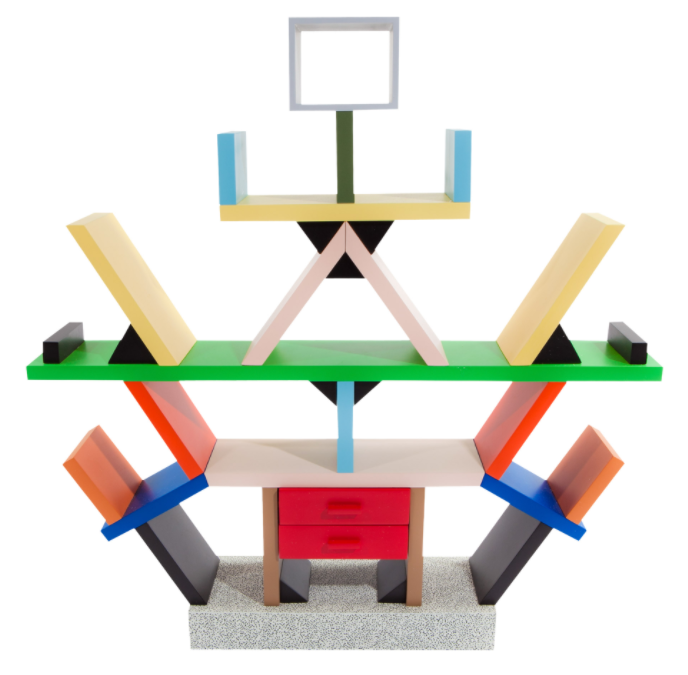- 1– Room Divider, ʻCarltonʻ, Memphis Milano, wood / plastic laminate, Ettore Sottsass, 1981.
- 2 – Chair, ʻFirstʻ, steel / wood, Michele De Lucchi, 1983.
- 3 – Shelf, ʻMiss Slat, wood, Sophie Colle, 2017.
Eclectic maverick designers in the 1980ʻs developed a design subculture based on fun and creativity. The Memphis Design movement wished to be free from puritanical design conventions which made art robotic and soulless1. They rejected the stiff forms of traditional design and were inspired by any and everything. The movement served as a testing ground for experimenting with new materials, shapes, colours, and signs. The primary colours, geometric shapes, and bold patterns are instantly recognisable throughout 1980s interior design and art2.
Originally created by Italian artists, this aesthetic movement found its way to Australia through dedicated Australian collectors buying and selling original and inspired pieces. With the nostalgia of the 1980s, Memphis Design has found new audiences willing to pay the cost for original pieces. Stores such as Esprit in Carlton and Georges Department Store in Melbourne champion the movement in Australia3. David Trimble, owner of Design Dilemmas in Melbourne, has said that the Memphis movement certainly was not popular with everybody. He suggests that some “did not understand the humour” a particular piece was trying to convey4.
It was difficult to apply traditional ideas of “good design” to the movement – conceptual creativity took precedence over functional design in many cases. This frustrated some, while others loved it.
“Memphis designers tore up the rule book, laughed at simple-minded notion of good taste and decided that design had to be about ideas, expression, passion, fun and wit, as well as globally relevant concerns.”
–Andrew Franklin, author of Collecting the 20th Century5.
The Memphis Design movement has been credited with being very inclusive, with influential designers of all genders emerging from around the world. Australian designer, John Smith, was an active influence on the Memphis Design movement for over 40 years. In Tasmania, Smith specialised in furniture and sculpture projects, and was awarded a number of design prizes6. His interest in colourful, geometric design seen in the Colourblock Coffee Table, 1984, exemplifies this. Smith drew inspiration from the Tasmanian environment, seen with his use of Tasmanian timber in the coffee table; where geometric wood pieces painted in glossy primary colours support a glass panel7. This piece, and others, is now part of the Museum of Applied Arts and Sciences collection.

Coffee table, ‘Colourblock’, wood / glass, John Smith, Tasmania, Australia, 1984 (MAAS collection 86/120)
Melbourne based interior designer Fiona Lynch, of Fiona Lynch Design Office, enjoys the playfulness and fun inherent to Memphis Design8. Lynch injects her spaces with geometric shapes, colours and patterns commonly found in the movement. Lynch does not attempt to replicate works of past Memphis designers, rather leaning into the spirit of the movement. Injecting bright colours and patterns into otherwise monochrome spaces adds character and fun regardless of traditional or trendy conventions.
The Memphis Design movement was fun, eclectic, and broke the conventional rules of design. The ground breaking work of artists in the past influences and inspires the present and future of art and design.
References
- 1 – Franklin, A 2010, Collecting the 20th Century, University of New South Wales Press, Sydney.
- 2 – Lupica, L, 2020, Get to know the Memphis-Milano renaissance shaking up our homes, Vogue Living, October 28.
- 3- Crafti, S, 2013, When weird was wonderful, The Sydney Morning Herald, June 2.
- 4 – IBID
- 5 – Franklin, A 2010, Collecting the 20th Century, University of New South Wales Press, Sydney.
- 6 – Boleyn, T, 2015, Obituary. John Smith. August 1948 – 24 February 2015, Museum of Applied Arts & Sciences.
- 7 – IBID
- 8 – Crafti, S, 2014, The Power of Bright: Memphis in Melbourne, Financial Review, September 16.


